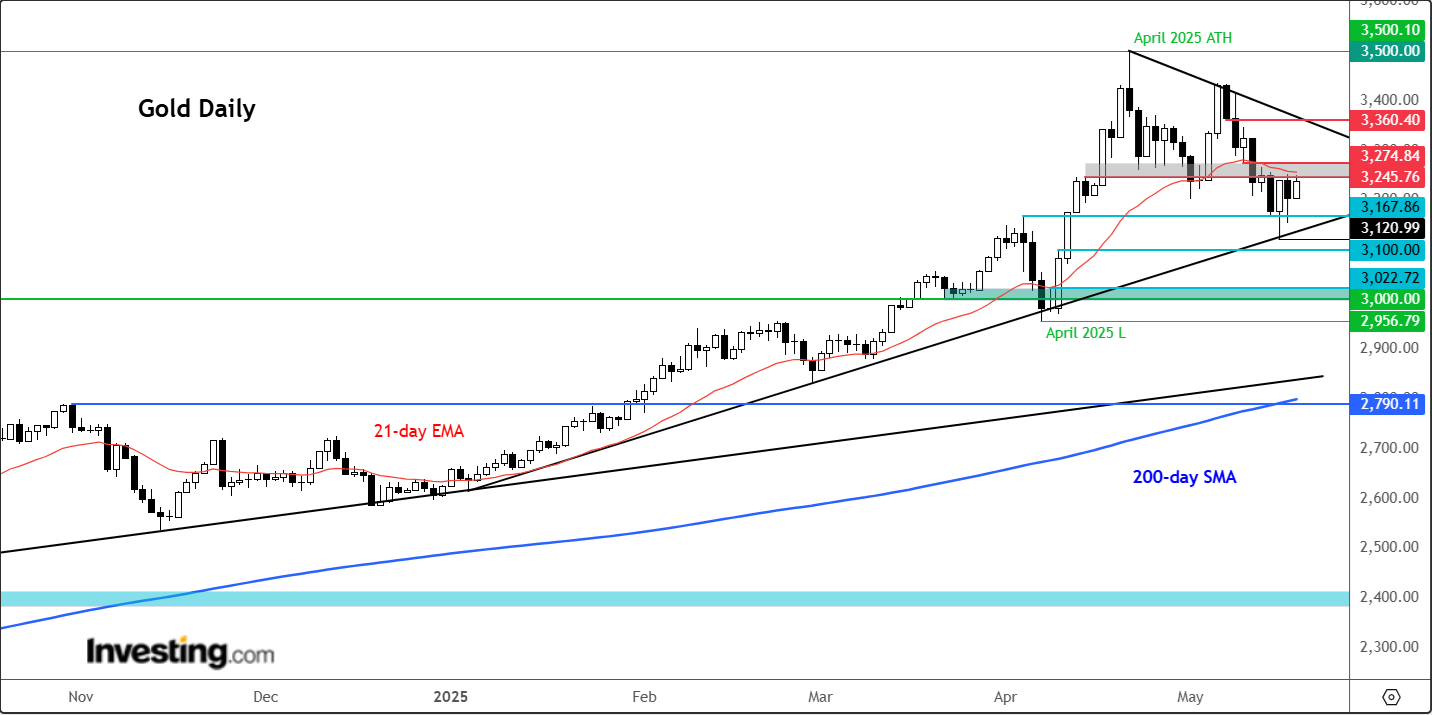ION expands ETF trading capabilities with Tradeweb integration
- Gold tests $3245–$3275 resistance zone as haven demand revives after Moody’s US downgrade.
- Technical breakout above $3275 could trigger fresh buying toward $3300 and $3360 levels.
- Bears eye $3200 and $3150 supports as key thresholds to regain near-term control.
- Looking for actionable trade ideas to navigate the current market volatility? Subscribe here to unlock access to InvestingPro’s AI-selected stock winners.
It appears the “Sell America” trade is echoing once again in markets, this time courtesy of Moody’s. The ratings agency’s downgrade of the US sovereign credit score has nudged 30-year Treasury yields to the psychologically significant 5% mark—raising alarm bells not just on Wall Street, but among global investors with a keen eye on Washington’s fiscal trajectory.
In response, we have seen a sizeable drop in US index futures, while haven assets like gold and yen have rallied, while the dollar has also sold off across the board.
Gold was testing a major battleground at the time of writing, so let’s look at the metal’s chart and discuss some levels first before turning our focus on the fundamental drivers of the markets today.
Gold Technical Analysis and Levels to Watch
From a technical point of view, gold’s near-term direction could be determined by whether the bulls will be able to reclaim broken support in the $3245-$3275 region. This area, marked in grey on the chart, has been a pivotal zone in recent times. A potential close back above this zone could signal the resumption of the bullish trend after the metal entered a corrective phase in the last few weeks.
This 3245-$3275 zone has since turned into resistance after initially serving as support. This is also where the 21-day exponential moving average comes into play.
If the abovementioned resistance range breaks, then this could potentially pave the way for follow-up technical buying towards the next resistance levels at $3,300 and then $3,360, with the latter also marking the short-term resistance trend.
In terms of support levels to watch, well, the $3,200 level has not been broken decisively yet, and will be the first trouble area for the bears to get through once again should prices dip. Below that $3167 is the next level down, followed by $3150, with the latter marking the 2025 bullish trend line.
The bears will feel in a bit of control if they can manage to push the gold price below the trend line and support at $3150. If that happens, then we could soon be talking about $3100, $3022 and then the $3,000 support levels as the next downside objectives.
What Is Driving the Markets Today?
In short, it looks like the “Sell America” trade is back. Moody’s made its move late in the day on Friday evening, knocking America’s credit rating down a peg—from Aaa to Aa1. At the same time, they were the last of the three major agencies to act, which didn’t stop futures from dropping and investors seeking refuge in safe assets.
Their rationale was a bipartisan failure to control a burgeoning budget deficit and soaring debt levels. Makes sense. Some would even argue - Why did it take them so long to reduce the US’s debt rating?
The debt rating downgrade has fuelled a predictable response across financial markets. Longer-dated yields spiked, with the 30-year benchmark breaching that key 5% level to reach territories not seen since the recent peak in October 2023. S&P 500 and Nasdaq futures sagged, as did the dollar, despite rising yields.
The greenback fell some 0.7% against a basket of foreign currencies, with the EUR/USD, once again, outperforming with a rise of 1%. Meanwhile, we even saw commodity dollars press higher despite the risk-off tone being emitted from the equities markets.
So, it seems like concerns about the sustainability of US debt have taken precedence over carry, amid growing concerns that higher yields will add to the government’s growing interest costs. This couldn’t have come at a more sensitive time, with President Donald Trump’s ongoing trade war situation and his proposals of unfunded tax cuts. Against this backdrop, the fiscal outlook hardly looks set to improve, which explains why investors are shying away from US assets.
Moody’s expects the government deficits to widen, reaching nearly 9% of GDP by 2035, up from 6.4% in 2024, driven mainly by increased interest payments on debt, rising entitlement spending, and relatively low revenue generation. This comes as China has reduced its holdings of Treasuries during the height of the trade war in the last couple of months.
But will it really be different this time? After all, the previous downgrades of US debt at the hands of other ratings agencies, such as the S&P, have had limited repercussions.
***
Be sure to check out InvestingPro to stay in sync with the market trend and what it means for your trading. Whether you’re a novice investor or a seasoned trader, leveraging InvestingPro can unlock a world of investment opportunities while minimizing risks amid the challenging market backdrop.
Subscribe now and instantly unlock access to several market-beating features, including:
- ProPicks AI: AI-selected stock winners with a proven track record.
- InvestingPro Fair Value: Instantly find out if a stock is underpriced or overvalued.
- Advanced Stock Screener: Search for the best stocks based on hundreds of selected filters and criteria.
- Top Ideas: See what stocks billionaire investors such as Warren Buffett, Michael Burry, and George Soros are buying.

Disclaimer: This article is written for informational purposes only; it does not constitute a solicitation, offer, advice, counsel or recommendation to invest as such it is not intended to incentivize the purchase of assets in any way. I would like to remind you that any type of asset, is evaluated from multiple perspectives and is highly risky and therefore, any investment decision and the associated risk remains with the investor.
